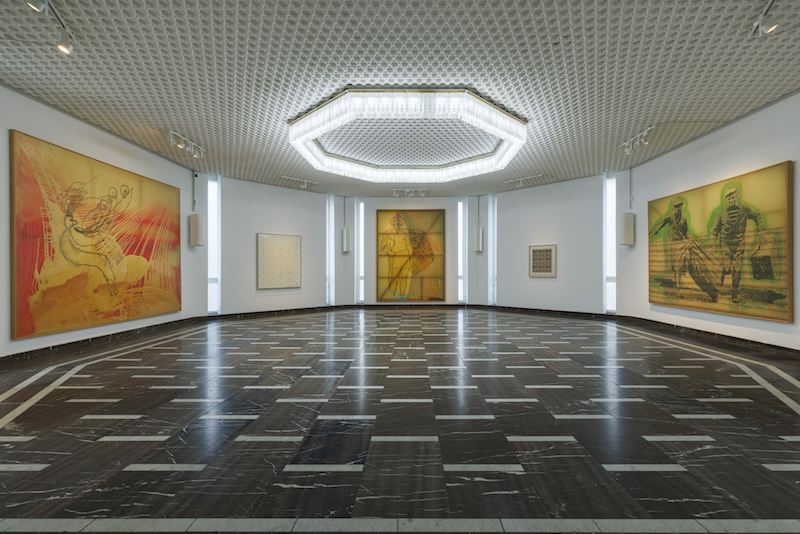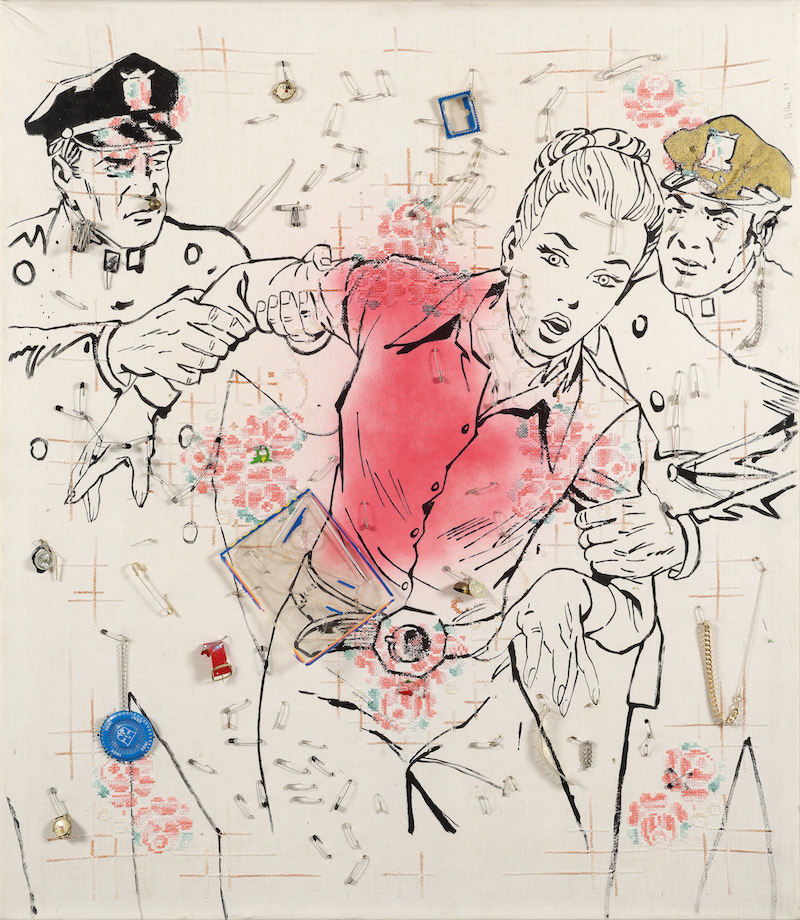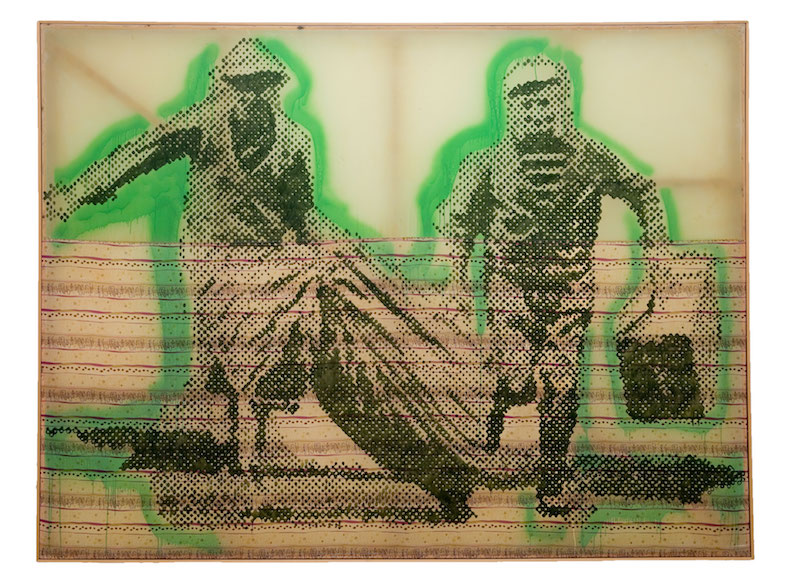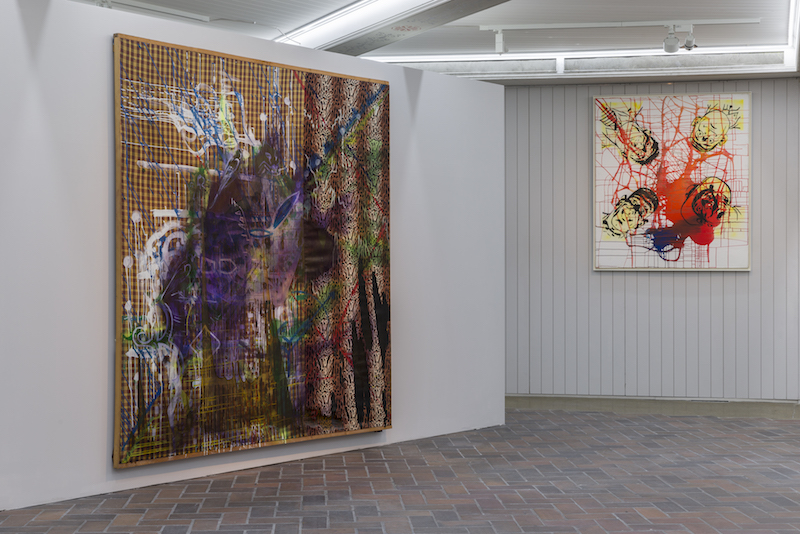by Jeffrey Grunthaner // Oct. 25, 2024
What stands out across the Sigmar Polke retrospective currently on view at Schinkel Pavillon is the artist’s entrenched relationship to the times he lived through. Framing him as a free-wheeling destroyer of market-driven society, ‘Der heimische Waldboden. Höhere Wesen befahlen: Polke zeigen!’ makes the case that Polke’s work retains its singular value less for the conceptual sophistication he routinely applied, than for the way he quite literally preserves, in a ludic aesthetic amber, the ersatz markers and keepsakes of a culture he was often opposed to.

‘Sigmar Polke. Der heimische Waldboden. Höhere Wesen befahlen: Polke zeigen!,’ 2024-25, installation view at Schinkel Pavillon, Berlin // Photo by Frank Sperling, VG Bild-Kunst, Bonn 2024
Curated by Bice Curiger, who was friends with Polke since the 1970s, and who is quite mindful of the difficulties inherent in organizing a show around such an institutionally well-represented artist, ‘Der heimische Waldboden’ shows us a Polke who was not only prolific at capturing culture by the tail as it whizzed past, but stakes his continued relevance on how he went about making art: the accessibility of the materials he used (often industrial fabrics) and the way form and accident elide into the overall style and significance of his work.

Sigmar Polke: ‘Ohne Titel (Sicherheitsverwahrung),’ 1979 // Courtesy of Schinkel Pavillon
Polke was a brilliantly imaginative artist, and his gift for making found objects do his bidding is still surprising today. Safety pins, for example, stipple the surface of his ‘Untitled (Sicherheitsverwahrung)’ [Preventive Detention] (1979). Alluding to the then-emergent punk movement, the draping of these reflective metal objects have a lapidary suggestiveness all their own. Sculptural as well as cultural, the theme of the work, a young woman running from police, seems almost like an afterthought, a prop, in light of the numerous gestures amplifying the picture: grimacing police officers in 1950s-styled uniforms, the rockabilly workers clothes the woman wears. Instead of making a too-easy statement about feminism, Polke seems to be toying with the neutrality of the image, taking it as a cartoon-like effigy and twisting it so that it unpacks differently with each additional viewing. It’s this mindfulness of the imbricated relationship indeterminacy bears to pathos that makes Polke’s themes and imagery so resonant today.

Sigmar Polke: ‘Flüchtende,’ 1992, Carré d’Art-Musée d’Art Contemporain, Nîmes // Photo by David Hugenin, © The Estate of Sigmar Polke / VG Bild-Kunst, Bonn 2024
In this way, even Polke’s celebrated picture of ‘Flüchtende’ [Fugitives] (1992) takes on a different nuance of meaning. The image he works with—originally a newspaper clipping—captures a German couple on the run. Carrying only their suitcases, they had come to symbolize the refugee experience. But Polke was not so jingoistic as to believe that a German couple could sufficiently represent refugees worldwide. As one observes in this work, the various interventions and maneuvers Polke layers into the fabric have the effect of almost rupturing and thereby de-politicizing the image. The spectral green that halos the couple makes them seem more than a little cartoonish; and the intensely replicated scale of what was originally newspaper print makes both figures seem more monstrous than relatable. Examined carefully, even the man’s mouth is a mere sequence of three dots.
All this variegated play adorning the surface of the fabric brings a certain irrefutable truth into the narrowest focus. No matter how enlarged, or how hotly discussed, the refugee experience becomes, it remains a unique event, opaque to outsiders. The neutrality of the substrate image, blindingly out of focus, enables us to see what can never be described in political terms: a complicity which silently surrounds us on all sides, on which we cast aspersions whenever it emerges too exactingly into the purview of our awareness.

Sigmar Polke: ‘Wo ist der Hirsch? [Where is the Deer?],’ 1983/84, privatsammlung; Sigmar Polke: ‘Die Schmiede [The Smithy],’ 1975, Privatsammlung, installation view ‘Sigmar Polke. Der heimische Waldboden. Höhere Wesen befahlen: Polke zeigen!,’ Schinkel Pavillon, Berlin, 2024/25 // Photo by Frank Sperling, VG Bild-Kunst, Bonn 2024
While not every work on view in ‘Der heimische Waldboden’ is a painting, I’ve focused on these works because they illustrate Polke’s penchant for reimagining, via scraps and tattered fragments, what Gilles Deleuze has called a “society of control.” Viewing the exhibition—which spans some 30 years and includes documentary videos as well as early photo works—I was sometimes led to compare Polke to another, younger German artist, Martin Kippenberger. Like the photos by Kippenberger that I’ve seen, Polke’s photos often feature himself in various costumes: sometimes the effect is satirical, sometimes they’re quite “aesthetic” (albeit in an over-the-top, romantic sense). But while Kippenberger was at odds with art history, placing himself in a secret lineage that swore by the legacy of Picasso, Polke’s early photo works already take to task the ostensive reality of portraiture itself. Like naturalism, or realism, or any form of “-ism” that dominates modern life, Polke’s photos make all the world into an existential fiction, where the illusiveness of documentation accelerates beyond anything resembling “negative capability” or a “voluntary suspension of disbelief.” The unreality that earmarks these photos is the same as the neutralized hyperreality that is visible in his paintings.
Exhibition Info
Schinkel Pavillon
Sigmar Polke: ‘Der heimische Waldboden. Höhere Wesen befahlen: Polke zeigen!’
Exhibition: Sept. 12, 2024–Feb. 2, 2025
schinkelpavillon.de
Oberwallstraße 32, 10117 Berlin, click here for map


















